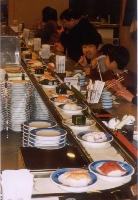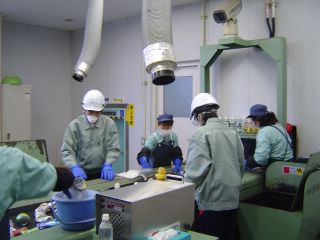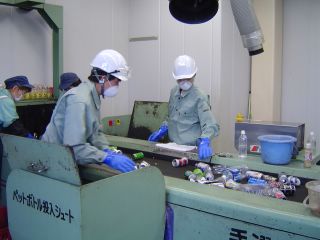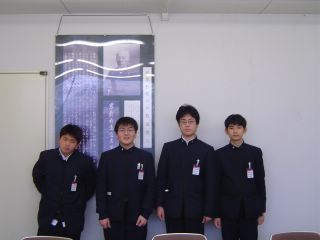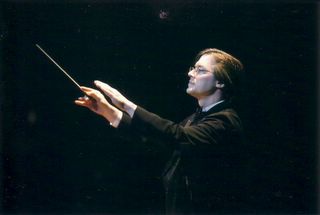The Menagerie in Studio Moodio
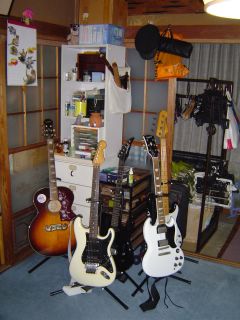
(If you think that's ridiculous, there's actually more behind me including a 12-string acoustic guitar among various string and electronic instruments. I also have another acoustic guitar at the school plus my two saxes and three clarinets.)
(No, I'm not rich.)
(No, my wife's not happy.)
I'm sure a lot of people would wonder, "Why the %#$& do you have so many guitars?" Well, you might also ask some people why they have so many pets. My friend in Singapore, Robin, has introduced me to his wonderful family of dogs (thanks, Robin!). My old friend the professor down in California, Dewkid, has also spoken of his trio of cats. I figured that, since they were kind enough to introduce me to their intimate companions, it's only proper that I introduce mine.
First I'll talk about the black guitar in the very center of the picture, and it really is black. Everything on it is black except the bridge and the machine heads. It's a Yamaha RTS 102, which is a discontinued model based on the Fender Telecaster. I bought it a few months after first arriving here in Japan. At the time, I picked it up because it was 70% off the original price (and I was still broke), figuring I'd trade it in once I had enough to get a "real" guitar. However, I wound up keeping it because it has served me very well. The pickups don't really have much oomph, so I've been thinking about replacing one or both of them, but it has done the job quite well. I've always used heavier guage strings on it than on the others and also keep the action fairly high so that it's perfect for "banging". It actually does have kind of an acoustic guitar feel to it, and that makes it ideal for rhythm guitar. In my earliest recordings I used it for both lead and rhythm, but since mid 1991 it has been my rhythm workhorse.
The bone-white and black guitar in front of the RTS-102 is my Fender (Japan) Stratocaster HSS. My friend and sometimes fellow performer (I am not worthy! I am not worthy!), guitar hero and music sage Paul "Crusty" Lauritsen says it's not a real Strat. He's right. In mid 1991 I actually bought a "real" Strat for lead work, but I sold it (to Jeff) a year later and got the Strat HSS. What's the difference? Well, for one thing, the Strat HSS is bulkier and a whole lot heavier (which is why Paul says it isn't "real"). It also has a "super-distortion" humbucking pickup in the lead position instead of the traditional single-coil type. However, the main reason I got it was for the locking tremolo system, which allows me to bend hard into every chord or even bang the tremolo bar against the body without the thing going out of tune. For the "prog rock" that I tend to write and record, it does a fine job. (I'd probably rather use a Fender Jaguar, since that seems to be a standard for British alternative and prog rock, but oh, well.) The Strat HSS has a wide range of sounds. The single-coil neck pickup gives me that nice, gritty, bluesy feel for which the Strat is famous, whereas the bridge pickup can punch out a wonderfully dirty, aggressive tone when I want one. I can also add in the middle pickup in or out of phase to round out the sound a little.
The pearl-white and black guitar to the right of the RTS-102 is my Epiphone (Japan) SG. The SG was developed by Gibson when, ironically, it stopped making its famous Les Paul model in the early 60s due to slow sales. (The Les Paul was put back into production in the early 70s, when artists such as Jimmy Page, Peter Frampton, and Ace Frehley made it popular.) The SG has been used by such artists as Pete Townshend of The Who, Angus Young of AC/DC, and James Iha of The Smashing Pumpkins. It has the same basic layout as the Les Paul, but with a thinner, lighter, double-cutaway body of solid mahogany rather than layered maple. Epiphone is actually a division of Gibson now, so you could say that I have a Gibson SG, albeit of a bit lower production standard (hence a lower price). Mine is very much the standard model with vintage pickups. It is a very light guitar, and the balance tends toward the headstock rather than the body (which takes some getting used to!). It has a very punchy sound which is excellent for rock but not always very adaptable for soft or clean tones (so I use the RTS-102 or the Strat [neck pickup] for those). Its neck is shorter than that of the Strat or the RTS-102 and has thicker frets spaced closer together. Because of that, I can usually move faster and smoother on it when playing (rock) leads (though the Strat feels better in bluesier solos and is good for short bursts of speed) and can also play a strong vibrato with more ease. I actually didn't like this guitar so much at first and was afraid I'd made a mistake in buying it, mainly since it went out of tune so easily, but it has since gotten better, and now I love it. (Still...I've been drooling over those Les Pauls in the music shop a bit too much for my own good lately...)
Okay, those are my three electrics. I think they complement each other well. Firm, chorded rhythm or a clean lead? RTS-102. Bluesy lead, dirty fill, or experimental noise? Strat. Punchy riff or "jammin'" lead? SG. Still, it's an interesting combination, partly because one of my favorite rock bands of the past decade has been The Smashing Pumpkins. Billy Corgan mainly used a Strat, and James Iha used an SG. Coincidence? I doubt it. Whatever...it probably doesn't matter. It also doesn't matter that all my electric guitars (and bass) are black and/or white. What happened to color???!? (In retrospect, the [cheap piece of junk] electric guitar I had before coming to Japan was BLUE!!!!!)
(Aw, fuggit! Maybe I should run out tomorrow and buy that purple PRS guitar I saw in [SMACK!!!!])
(Thanks...)
Incidentally, the bass is a Fender (Japan) Precision. The acoustic guitar in the picture is an Epiphone, as is the 12-string leaning against the wall behind me. Epiphone acoustics are actually very highly rated and many people swear by them. (I've heard that John Lennon actually used one of that same model at one point.)
What other instruments can you see in this picture? Well, let's see... There's a flute, a bamboo flute, a crystal piccolo, a fife, a shakuhachi, soprano and alto recorders, five Irish tinwhistles (2 C, 2 D, 1 F), a kalimba, 6 harmonicas (all different keys), a shichiriki, an ocarina, two turtle doves, and a partridge in a pear tree.
So why the hell am I sitting here typing about them when I could be playing them??!? 'Kay...gotta go.




